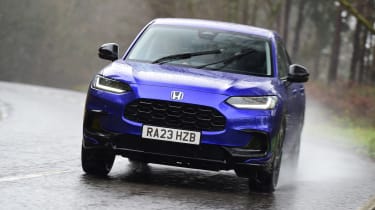Honda ZR-V Sport long-term test: a comfortable, spacious and efficient SUV
Final report: we look at Honda’s history of hybrid tech as we say farewell to our SUV

Verdict
The ZR-V is efficient, engaging and relaxing to drive, in addition to being impressively equipped. It has served well as both family transport and a speedy ‘exec express’ on work-related trips – in particular proving extremely comfortable after long hours at the wheel. It’s a shame there’s no four-wheel-drive option, which would be useful for some owners, but otherwise it’s an attractive all-round package.
- Mileage: 9,478
- Economy: 47.4mpg
Over the years, I’ve enjoyed getting to know a wide range of cars on extended ‘long-term’ test loans, from superminis to V10-powered muscle coupes, and everything in between. But one of my all-time favourite loaners is something of an oddity – namely the futuristic-looking Honda Insight coupe, which introduced the first generation of the brand’s hybrid tech, in the form of Integrated Motor Assist.
Compared with the latest iterations of hybrid technology from Honda and others, this IMA set-up seems almost laughably simple today. A 13bhp electric motor on the crankshaft gave the Insight’s 67bhp three-cylinder engine a boost under acceleration, powered by a pack of 120 D cell NiMH batteries behind the two passenger seats, which recharged on the over-run.
This was claimed to give the 1.0-litre Insight the performance of a 1.5, but I loved the car mostly for its ultra aerodynamic, tapered bodywork, light weight and vibrant orange recycled-plastic trim that contrasted brilliantly with ‘my’ car’s glossy black paint. It was also great fun to drive, although I recall the aero styling being worryingly susceptible to crosswinds at speed.
More reviews
Car group tests
In-depth reviews
Road tests
A recent trip to Honda’s logistics centre to return our ZR-V loaner inspired the flashbacks, because the firm keeps a vivid green example of the Insight on its historic fleet, alongside a number of its more sporty offerings. Does that make me ‘historic’, too, I wonder? Either way, it’s interesting to contrast and compare hybrid tech a quarter of a century later – which, in the case of the ZR-V, means Honda’s e:HEV set-up.
Twin electric motors work in conjunction with a 2.0-litre Atkinson-cycle engine, to deliver punchy performance that’s said to be on a par with a standard 3.0-litre internal-combustion engine. Interestingly, that’s the same 50-per cent performance hike claimed for the Insight at the turn of the century.
In the ZR-V, thanks to a combined total of 181bhp, the e:HEV officially delivers 0-62mph in 7.8 seconds, with impressive WLTP figures of 130g/km of CO2 and 49.5mpg – although our own ‘real-world’ test conditions were more likely to deliver mileage in the high 30s, due to doing a lot of fast motorway work. That said, when driving at 40-60mph on single-carriageway or B-roads, we also frequently hit 60mpg, and, of course, around town the ICE engine barely kicked in at all, meaning fuel consumption was negligible.
The EV mode (which self-selects automatically) is a superbly relaxing way to negotiate town driving, too, and even when the ICE engine does kick in, the switchover to either petrol/electric drive or direct petrol drive for high-speed motorway cruising is generally all but imperceptible. I found that only occasionally did the subdued thrum of the petrol engine make
itself heard, and it was never intrusive.
I’ve previously extolled the virtues of the ZR-V’s comfortable front and rear seats, and the boot size is decent, too – but there were a few flies in the ointment. Both related to the cruise control, and the first was a fiddly steering-wheel control that my sausage fingers couldn’t get to grips with. Setting or resuming a chosen speed simply required more dexterity than I could muster, which usually led to frustration and distraction as I made a more careful second attempt.
The ACC cruise control is a technically impressive, active system that reacts to traffic ahead, but our second problem was its tendency to slow down far too much in response to vehicles changing lanes, and then taking too long to speed up again. For example, if we set the system to 70mph on the motorway, and came up behind a car doing 60mph, the ZR-V would still be slowing and thinking about its next move while the car in front had already moved over. We typically then had to jump on the gas to avoid an embarrassing incident, with the car behind being surprised by our failure to keep up with the flow. It all rather defeats the purpose of the active cruise system.
If you don’t do many motorway miles, or they’re on less busy routes, this will be much less of an issue. And to be fair, I’ve used the ACC system happily on various long West Country jaunts, and been glad of it.
Indeed, the ZR-V has proven a worthy and engaging companion for the past three months, and I’ll be sorry to see it go.
Honda ZR-V Sport: first report
Our spacious hybrid Honda ZR-V SUV passes its first test with flying colours on trip to Cornwall
- Mileage: 4,606
- Economy: 47.4mpg
Having spent time living with Honda’s excellent HR-V recently, I was pleased to be offered its bigger brother, the ZR-V, for a few months. The ZR-V not only offers usable room in the boot for our (not-excessively) Large Munsterlander dog (the HR-V’s sloping tailgate meant the load bay was just too confining), but also has a similarly spacious cabin and more oomph from a 2.0-litre petrol/twin electric motor hybrid set-up. It’s lifted from the Civic hatch, along with its entire platform, whereas the HR-V has a 1.5-litre hybrid powertrain.
Our ZR-V Sport arrived just before the Christmas break, with its ‘Still Night Pearl’ paintwork set off by a handsome set of chunky black-painted 18-inch wheels. While it’s similar in outline and proportion to any number of medium-SUV rivals, Honda’s designers have developed a sleek exterior with edges rounded like a newly-wetted bar of soap. Slim LED headlamp clusters and A-pillars, plus an unusually smooth roofline – the press info mentions a laser-brazing technique that eliminates join lines on the roof panel – and simple, unembellished flanks combine to good effect, but I’m not sure whether the ZR-V’s finer design points will stand out to casual observers. I’m pretty sure the exterior could happily pass as a design from a European premium brand.
The interior doesn’t inspire me in the same way, though, because it short on some of the European-market focused HR-V’s design brio. The ZR-V’s cabin is basically similar to that of the Civic, which means conventional and somewhat mainstream; – which, of course, it is in Honda’s biggest market for this car, the US. Over the pond, (where confusingly this car is badged as the HR-V), our Sport model has a retail price of $27,500 (to which you might typically add a 10 per cent car-sales tax in states that apply one), and you wouldn’t argue with the interior ambience at that money.
Over here the RRP is a more punchy £41,095, with an extra £650 for paint. That’s not to say the ZR-V is overpriced relative to its rivals in the UK – you can pay £42k for a hybrid Nissan Qashqai – but I’d like a bit more ‘premium feel’ inside for the money.
I have no complaints with the way the ZR-V goes, or doubts about its impressive comfort levels on my first long drive, a
10-hour trip to Cornwall and back from home. From memory, the cabin is significantly more hushed than the HR-V, and the seats are extremely supportive, especially when it comes to holding occupants in place when cornering, with excellent side bolstering on the backrest.
Body roll is controlled, and the HR-V feels stable at motorway speeds. It coped reassuringly with a lot of surface water in Cornwall on its big 225/55 R18 Dunlop Sport Maxx tyres. The car responds well to the throttle, too, feeling decently fast, and with none of the intrusive engine drone we used to associate with hybrid /CVT set-ups.
Accurate, well weighted steering makes placing the ZR-V easy, even on twisty roads, but the curvy body details mean it’s not always easy to judge the car’s extremities, whether that’s on a narrow Cornish lane or in a tight multi-storey car park. The front screen pillars appear quite slim when looking forward, where visibility is good, so it’s the car’s flanks that are hardest to gauge.
I’ve swapped to the ZR-V from a superbly efficient hybrid Toyota Corolla, so have high hopes for the Honda’s economy. My Cornish journey saw an average of 41.6mpg on the trip computer – pretty good for a bulky car
| Model: | Honda ZR-V e:HEV Sport |
| On fleet since: | December 2023 |
| Price new: | £41,095 |
| Engine: | 2.0 litre i-MMD Hybrid, e-CVT 141bhp/181bhp (petrol/electric) |
| CO2/tax: | 131g/km/£560 |
| Options: | Metallic paint (£650) |
| Insurance*: | Group: 35/Quote: £1,248 |
| Mileage: | 9,478 |
| Economy: | 47.4mpg |
| Any problems? | None so far |
*Insurance quote from AA (0800 107 0680) for a 42-year-old in Banbury, Oxon, with three points.







